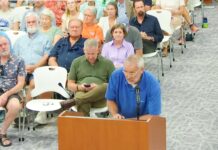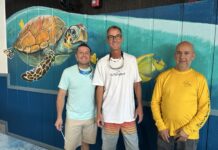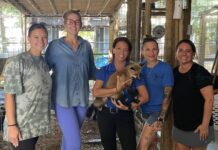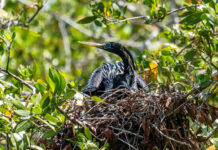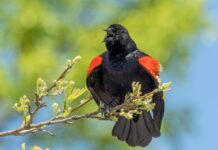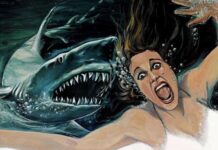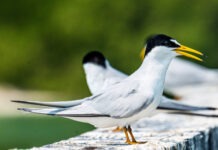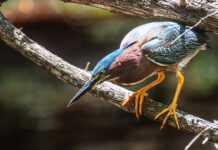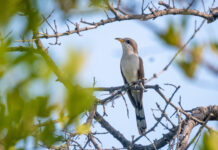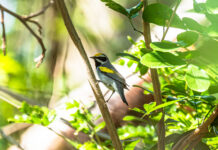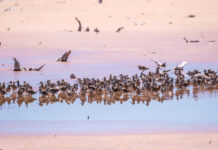In the proper scheme of things we, as humans, are not supposed to occupy intimate space with a bird like a Cory’s shearwater. Shearwaters are pelagic birds, designed to spend their lives amidst the grinding water and the gasping wind of the deep ocean, coming to land only on uninhabited rocky islands to breed and raise their chicks, and even then, spending a good bit of their time on days-long foraging trips.
They feed on fish and other aquatic creatures, sometimes picking things off the surface, sometimes diving almost 50 feet below. They are so built for a life at sea that they drink seawater and expel the excess salt out of their oversized nostrils.
Mostly you see shearwaters from a ship or a boat, far from shore, and only briefly. They move fast over the waves – faster than any boat designed to be out there – earning their name by skimming low over the wave tops.
Audubon’s shearwaters are seen pretty regularly in these parts. Cory’s shearwaters are only reported every few years. So it was odd to have one sitting in a cat carrier in the back of my boat.
The bird had come into Key West riding on a high-class hooker. Correction: Riding on the High Class Hooker, a deep-sea fishing charter based out of Key West Bight. The bird had gone after some of their bait, then gotten tangled in a line. The fishermen were worried a hook might have damaged a wing.
After they untangled the bird, they sat it on the gunwale, expecting it to fly off. It rode there all the way back to Key West, so they called the folks at Key West Wildlife Center, who went down to the docks and picked it up.
“It is not the patient you want to see come through the door. You want to do a good job, but they are so difficult because they are so unusual,” said Peggy Koontz, who manages the clinic at the Key West Wildlife Center.
“How do you treat an animal that comes to land four weeks out of its life?” Koontz asked. (They actually come to land a little longer, but not much.)
Shearwaters are known for their orneriness, at least when being held. They dislike being in cages, especially at night. They like to bite. Hard. With bills designed to keep wriggling fish in an iron grip.
When I stopped by the other day, Koontz showed me a bruise on her forearm.
“That’s a shearwater,” she said. “They can bite.”
Koontz says she has a scale for getting bitten by seabirds that goes from double-crested cormorant (hard) to magnificent frigatebird (really hard) to northern gannett (really, really hard). The Cory’s shearwater ranked with the frigatebird.
The first thing the Wildlife Center folks do when a bird like that comes into the clinic is check the feather condition, Koontz said.
Pelagic birds’ feathers are finely structured to keep them from absorbing water, which makes them delicate.
“We are incredibly careful of the feathers. We want him in pristine condition so we can kick him out the door as soon as possible,” Koontz said. “His feathers were perfect.”
Next they assessed body weight.
“He was not skinny at all,” she said.
He also had good coloring in his mouth and feet – the two places on a bird that blood flow can be assessed.
Best of all, when she assessed the shearwater’s structure, there were no broken bones.
It turned out they might be able to get the bird out the door in less than 24 hours.
“The quicker the better with (a bird) like that,” she said.
When Ellen Westbrook, who volunteers at the Key West Wildlife Center, mentioned that a few of us from Florida Keys Audubon were heading out on a boat trip into the backcountry the next day, Peggy asked if we could release the bird from the boat.
In the parking lot of the marina the shearwater bit at the wire door of the cat carrier like the tiny seagoing dinosaur it was. To a creature that spent its life cruising over vast tracts of open ocean, a cage was no doubt a frustrating, if not terrifying, indignity.
Elizabeth Ignoffo kept an eye on the bird in the back of the boat as we made our way out through the Lakes. She said he would periodically come to the door, take a look around, then retreat to the back of the cage.
Koontz said they’d treated a band-rumped storm-petrel a few weeks back. When it was ready to be released, they took it up the Keys and let it go at the end of someone’s dock, and the bird just sat there, refusing to fly until sunset. She worried that the shearwater would do the same. So she asked if we could release the bird near an island so he could shelter in the mangroves until dusk if so inclined.
After about half an hour of running we found a spot that looked good. There was an island nearby that nobody ever really kayaked near, and there was a clear shot to the open water of either the Atlantic or the Gulf.
Mark Whiteside held the cat carrier. Westbrook put on a pair of large leather gloves that made her look a bit like she had Mickey Mouse hands. When she pulled the shearwater out he bit at her fingers.
Westbrook took the bird to the edge of the boat and let it go with a small push.
The bird fluttered down to the surface of the water, then fluttered a little bit more, then just floated with his wings held up like he was frozen in some kind of martial arts karate stance. The breeze pushed the bird towards the stern of the boat, away from the island.
If he continued to float like that until dark there was a good chance he’d drift into an area with more boat traffic. We worried about this for about 30 seconds until he gave his wings a good downbeat and lifted off.
He turned himself north and headed towards the Gulf. He went from a bird to a dot on the horizon faster than you would believe.
“That is cool,” Whiteside said. “That is fantastic.”
And it was.
Got a bird question you’re dying to ask, or even just mildly curious about? Email “Ask the Bird Geek” at mark@markhedden.com.



